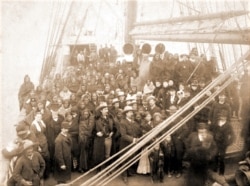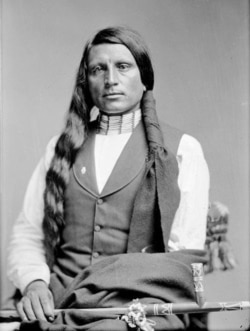When the Pilgrims arrived at Plymouth in 1620, one of the first Natives they met was Squanto -- portrayed in history books as the friendly, English-speaking Wampanoag who helped the newcomers survive their first year in New England.
“The casual consumers of history hear about the founders of the Plymouth Colony and make them out to be brave heroes who suddenly encountered a Native who spoke English,” Mashpee Wampanoag historian Paula Peters said. “No one asks how he learned English, and if they did, they would learn that Squanto learned English after he was kidnapped in 1614.”
Much of Squanto’s story is clouded in mystery, but historic texts offer some detail.
In his 17th-century journal, “Of Plymouth Plantation,” Plymouth leader William Bradford explained that an English ship captain on a fishing and trade expedition kidnapped Squanto and about 20 other Wampanoag men and took them to Spain to sell as slaves.
With the help of Catholic friars, Squanto escaped to England. Several years later, he made his way home to the new colony of Massachusetts, where he played an important role mediating between the colonists and the local Wampanoag Nation.
Living evidence
Squanto wasn’t the first Native American to experience England. Historians estimate that between 1500 and 1776, some 175 Natives traveled to England, some unwillingly, some voluntarily.
In 1576, for example, explorer Martin Frobisher sailed to Canada with instructions to bring back several inhabitants. At Baffin Island, he lured several Inuits to his ship by ringing bells. He plucked one man, leather kayak and all, aboard his ship and transported him to England. A 1584 account of the incident states the distraught Inuit “bit his tongue in two within his mouth.”
University of British Columbia historian Coll Thrush is the author of “Indigenous London.”
“Frobisher was basically using this to prove that he got to Newfoundland and that he was a reliable investment,” Thrush said.
Showpieces
Early Native visitors to England were exhibited “quite cynically and mercilessly,” said University of Kent (England) historian David Stirrup, the principal investigator of “Beyond the Spectacle,” an online project mapping the historic presence of Natives in Britain.
“They were either held up as anthropological specimens for study or, by the 18th century, they were paraded around London with gawking crowds following them wherever they went,” he told VOA.
Bridging language gaps
Communicating with Natives would be key to colonizing America, according to Clark University historian Alden T. Vaughan, writing in “Transatlantic Encounters.”
“Until enough Englishmen became bilingual [it was agreed], Indians should be brought to London for linguistic training and cultural indoctrination,” he writes.
Among the first “test cases” were Manteo and Wanchese, whom Sir Walter Raleigh brought from the Carolinas to London in 1584. Manteo would help the English settle their first colony, Roanoke Island. Wanchese, however, rejoined his tribe and worked against the colonists.
In the 18th century, a different pattern emerged, Vaughan said.
Alliances with -- not control over -- Native American tribes were critical in Britain’s competition with France in America. Now, Native Americans willingly traveled to England to assert their bargaining power.
In 1710, as Vaughan details in his book, four delegates from the Iroquois confederacy sailed to London to bolster trade and cement a military alliance. Dubbed the “Four Kings,” they were given fine clothes, wined and dined and escorted as tourists.
Other Native emissaries would follow.
“In some cases, they went back home with very profitable trade treaties and military alliances, as well as quantities of gifts to distribute back home,” Vaughan said.
In the end, Vaughan said it was Britain that benefited most: “The Empire established alliances with tribes who otherwise might have given their loyalty to French or Spanish settlers.”
Performers
Nearly three centuries after the Plymouth Landing, the so-called “Indian Wars” had ended. Native Americans were now consigned to reservations and forced to live on government rations.
For some, the Buffalo Bill Wild West show offered a way off the reservation.
In 1883, aware of the public’s fascination with the “vanishing” frontier and Indians, former buffalo hunter and U.S. Army scout William “Buffalo Bill” Cody formed his traveling show. Part circus, part rodeo, part fabricated history lesson, it made its first tour in England in 1887.
Cody hired hundreds of Native Americans to display riding skills and participate in reenactments of stagecoach attacks, buffalo hunts and battles with the U.S. Army.
“It was a chance for them to earn some money and see some sights and come home with stories to tell and money to spend,” Vaughan said. “But it came at a price of playing the fool, of being dressed up and told how to behave and what sham battle to participate in.”
Some performers complained of abuse. On his return to New York in November 1890, Sunkowa (known as Painted Horse) told reporters, “We were beaten, kicked and shot at … our money was not paid regularly … the food Buffalo Bill supplied was bad."
But others, like Oglala Lakota leader Red Shirt, enjoyed celebrity status. Handsome and “every inch a man born to command,” he was presented to Queen Victoria and other dignitaries.
In an interview with the Sheffield Leader newspaper, Red Shirt showed tact in relating the condition of the reservation Indian.
“The United States government is good. True, it has taken away our land, and the white men have eaten up our deer and our buffaloes. But the Government now gives us food that we may not starve.”
But he warned that not all American Natives were as forgiving as he.
“The red man cannot kill all the white men, who live in villages as big as the largest forests," he said. "But some of our young men do not know this, and they may, perhaps, elect to die like their fathers, with their tomahawks in their hands, rather than to starve to death like dogs upon the prairie.”











